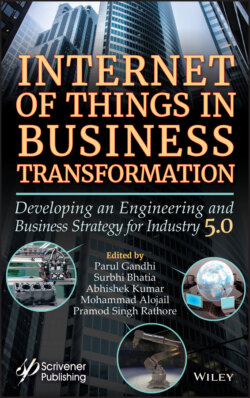Читать книгу Internet of Things in Business Transformation - Группа авторов - Страница 32
3.2 Literature Review
ОглавлениеAs the patient’s lives are dependent on the data traveling from both inter and intra-BANs network, it needs to be secured. Researchers proposed different techniques, some techniques form clusters among the sensors nodes on a single body, the reason to make these clusters is to efficiently utilize the energy of the nodes in tier 1 transmission. On the other hand, cluster formation in inter-BAN nodes of different WBANs is for efficient hop-to-hop routing for tier 2 transmission. A multi- hop routing protocol is proposed by Sriyanijnana et al., it performs well in the perspective of energy consumption, Packet Delivery Ratio (PDR) and network lifetime [2]. A number of fixed nodes are deployed in the network. A cost function is calculated for or the purpose of selection of Forwarding-node. The defined cost function is based on distance from the coordinator nodes, transmission range, residual energy, and on velocity vector of receiver. With clusters a dual sink approach used by DSCB [3], this clustering mechanism use two sinks. They also used the cost function for the purpose of selection of forwarding nodes. Forwarder node is selected by measuring distance of nodes from sink, its residual energy and transmission power. This clustering mechanism provides better performance in the prospective of network scalability, energy and an end to end delay.
A Balanced Energy Consumption (BEC) protocol is designed by [4]. In this protocol the relay node is selected with cost function which is based on distance of node form sink. To distribute load uniformly each relay node is selected for a specific round. Nodes nearer to the sink can transmit data immediately to the sink, otherwise data is passed to closest relay node. A threshold value of residual energy is also fixed on meeting the threshold value node only send critical data to sink. A simulation study has shown the better performance in term of network lifetime. Another attempt to achieve better throughput in terms of energy-consumption is achieved in heterogeneous WBAN [5]. It also works on the same principal. Residual energy, data rate and distance from sink, is the basic selection criteria for selection of relay node. Key requirement of any WBAN is minimum delay and energy efficiency. To improve the clustering in WBAN a load balancing and position adaptive technique is proposed by [6]. For the selection of cluster head the author used probability distribution method. A centralized clustering method is proposed by [7] to optimize the consumption of energy in WBAN. The cluster tree based structure is designed for the formation of uniform clusters.
An adaptive routing protocol is deployed by the author in [8]. The channel/link information is used for the purpose of selection of best relay nods for reduction of energy consumption per bit. Sender node only sends the data to sink, by relies on nodes only when the link quality is up to the predefined level of threshold. Otherwise it transmits information to the sink, directly. Omar Smail et al., proposed an energy efficient routing protocol for WBANs [9]. They use residual energy to increase network lifetime. This method used to select energy efficient stable links. In [10] a fuzzy adoptive routing protocol is proposed. It uses clustering mechanism for direct communication with sink node. In decision of forwarding it takes in account the criticality and location. Another routing protocol is proposed by [11] in which routing is managed by mobile-sink, it discovers the shortest route among numerous unequal clusters. This makes sure to avoid the energy hole problem in the network. Results have shown that this clustering technique performed well. A secure cluster base strategy for both inter-WBAN and intra-BAN is purposed by [12]. For intra-WBAN they used to generate a pairwise (PV) key. The best thing about PV is the keys generation on both sending and receiving end is the same. In the result of the highly dynamic nature of the human body, generated PV is time-variant. In inter-BAN communication, clusters are formed on the bases of two parameters (residual energy and distance). The node which has more energy is more likely to form clusters, in the same way, the node that is more closer to the RBS will have a high probability of becoming the cluster head. Some other authors also used genetic algorithms in WBAN [13–16]. A concept of a virtual cluster is given by [17], they form clusters only among intra-BAN nodes. Although nodes in intra-BAN are fairly close to each other, but due to energy limitation in sensors nodes, this technique gave remarkable results.
